Fall Foliage in New York’s Hudson Valley and the Hudson River School that Captured It
categories: USA TravelCenturies of Inspiration
Since the day in 1609, when Henry Hudson turned his ship up the mysterious river now bearing his name, the Hudson River Valley’s stunning natural beauty inspires and exhilarates all who visit. Stretching from Troy, New York in the north to the outskirts of New York City in the south, the valley offers travelers near-endless opportunities to explore how art and nature have intersected here for almost two centuries.
This connection is never more evident than in autumn, as the region’s green forests transform into vibrant colors of orange, yellow, and red — in some spots, stretching as far as the eye can see. Looking out from one of the Hudson River Valley’s many mountain viewpoints, one can almost see back into time at a landscape that remains very much unchanged despite humanity’s never-ending march towards the future.
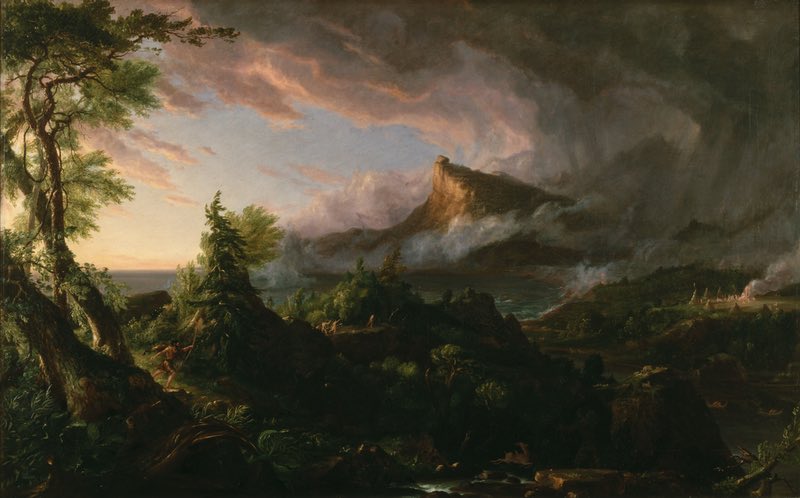
Thomas Cole The Course of Empire (1833-1836)
An Artistic Movement is Born – The Hudson River School
Some 200 years after Hudson first charted this then-undiscovered country, a young painter named Thomas Cole traveled up the Hudson River, settling in Catskill, New York. Cole immediately set out to explore his new home while memorializing its forests, rivers, and mountains in a series of landscape paintings.
Cole possessed a unique point of view. Rather than merely recreating the world before him, Cole infused his work with a greater sense of purpose and meaning, tapping into a young country’s enthusiasm for the promise of America itself. Cole was eventually joined in his work by a group of like-minded artists, including well-known painters like Frederic Church — a student of Cole — and later, Jasper Cropsey. Eventually, the movement Cole pioneered, came to be known as the Hudson River School.
Today, this artistic movement saturates the region’s spirit. A fall trip to the Hudson River Valley provides travelers a majestic natural backdrop from which to view the work of these visionary painters, while at the same time offering greater insight between the artists and their muse.
As the river runs south through the valley, travelers can explore the natural areas first immortalized by these early American masters, while viewing many of these essential works in person at the museums and cultural centers scattered throughout the valley. It’s here, where art, nature, and history join together in one remarkable cultural stew that may never be seen again.
 Camp in the Middle of it All
Camp in the Middle of it All
As the co-owner of an RV rental company, I’m always in search of my next great trip. There’s nothing I love more than loading up my motorhome and hitting the open road, intent on discovering something I’ve never experienced before. The area around the Hudson River Valley offered just that. Not only could I meander through the valley’s winding rural roads while taking in the fall colors, but I also was never too far away from the next stop on my itinerary.
As I began planning my trip, I needed to find a centrally-located camp spot that provided easy access to nature as well as the cultural attractions I wanted to visit. Fortunately, the North-South Campground fit the bill perfectly. Nestled within the Catskill Forest Preserve, the North-South Campground is adjacent to many of the natural areas Thomas Cole and his colleagues loved so much. Once settled, I was free to venture out on my own, content in the knowledge that I had a comfortable home base to return to.
Thomas Cole National Historic Site
Our Hudson Valley Tour begins less than 20 miles east of the North-South Campground at the Thomas Cole National Historic Site. Driving down from the mountains and into the valley, travelers will move through a seemingly endless canopy of beech, hemlock, maple, and oak trees, all alive with fall colors. After a few minutes, you’ll emerge in Catskill, New York on the banks of the Hudson River.
Located in Cole’s old home and studio, the Thomas Cole National Historic Site seeks to preserve Cole’s place as founder of America’s first homegrown artistic movement. Not only does the museum display some of Cole’s own work, but it also features exhibitions of work from artists inspired by Cole, or who create in Cole’s landscape tradition. Visitors can tour the site’s four buildings every Tuesday through Sunday from 10 a.m. – 5 p.m.
Olana State Historic Site
Stop number two lies on the eastern side of the Hudson River, just a short drive across the Rip Van Winkle Bridge — named for Washington Irving’s notorious character who took a 20-year nap in the Catskill Mountains. Called Olana, this hilltop estate looks out over the Hudson River and the surrounding valley and was once home to Hudson River School artist Frederic Church.

Church, Frederic. Autumn. 1875, Thyssen-Bornemisza Museum
Born in 1826 — just one year after Thomas Cole moved to Catskill — Church grew to show great artistic promise. At the age of 18, Church became Cole’s pupil after being introduced by a mutual friend. Together they traveled and painted scenes from the Hudson Valley, New England, and beyond.
By the mid-1800s, Church had become one of America’s most recognized, successful, and wealthy painters. With his riches, Church purchased 18 acres of hilltop land and built a mansion he named Olana where he lived with his wife and children.
Today, the property is owned by the state of New York and operates as a historic site dedicated to preserving its place as a vibrant home of the arts. Visitors can see a selection of Church’s work and participate in many art festivals and activities held throughout the year.
Touring the Famous Hudson River School Sites
Dotted throughout the Hudson River Valley and the Catskill Mountains are spots where Cole and his followers returned to time and again to paint their most famous works of art. By visiting these sites in person, travelers gain a deeper appreciation for the natural beauty that inspired the work of Hudson River School artists. Three of the most well-known sites sit just a few minutes away from the North-South Lake Campground.
These destinations are all well preserved, and accessing them requires visitors to hike short distances over trails of varying difficulty — so don’t forget to pack your hiking boots. Starting in September and throughout October, these trails will all be ablaze with vibrant autumn colors, adding another layer of majesty to the natural surroundings Cole and his followers visited so long ago.
North-South Lake
An early subject of Thomas Cole’s work, North-South Lake was once two distinct mountain lakes separated by a natural damn. Today, the North-South Lake Campground sits on the shores of North-South Lake and offers camping and day-use facilities for the area’s many visitors.
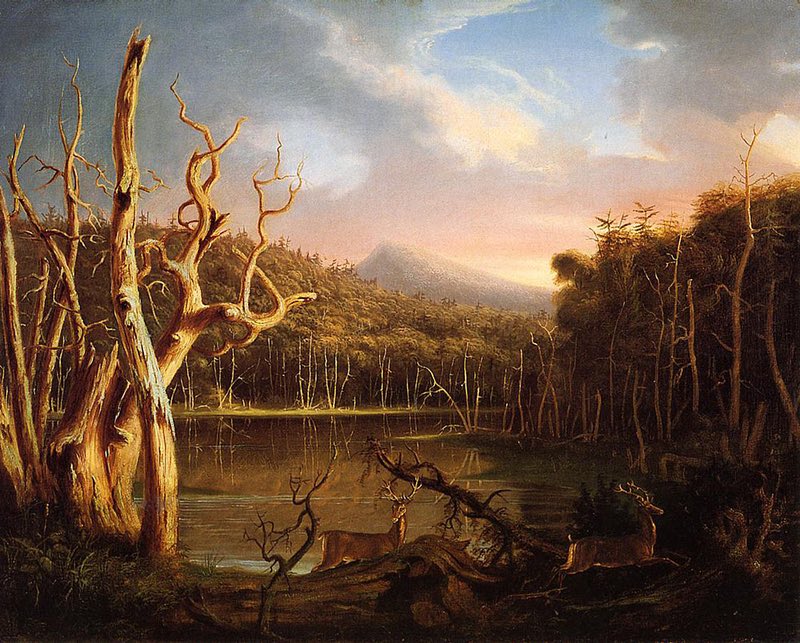
Cole, Thomas. Lake with Dead Trees (Catskill). 1825, Allen Memorial Art Museum.
The spot offers travelers a picturesque venue for enjoying fishing, swimming, non-motorized boating and hiking along the area’s many trails.
The Catskill Mountain House
One of these trails leads to the site of the former Catskill Mountain House — once one of the country’s most famous hotels. Initially opened in 1824, the mountain house offered visitors a sweeping view of the Hudson River Valley and beyond.
As the Hudson River School movement grew, artists, U.S. presidents, and other members of the American elite traveled here to take in the pristine view of the area’s natural beauty for themselves. Eventually, the house fell into disrepair and was burned down in 1963 by the state of New York.
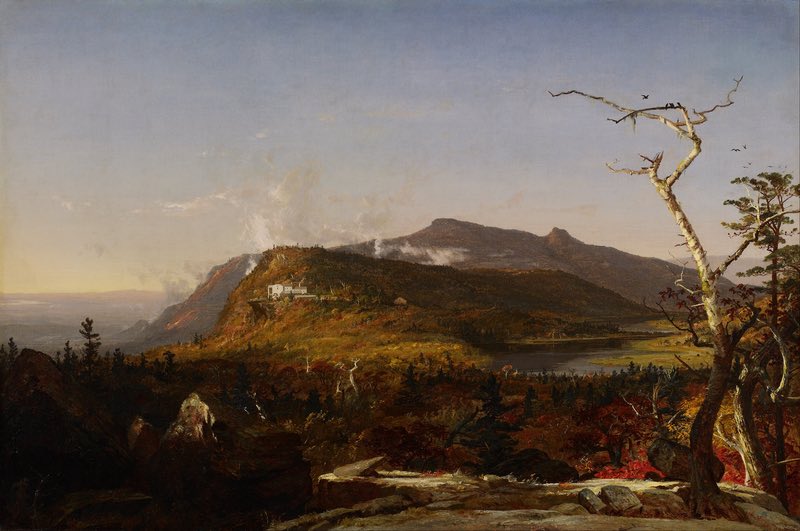
Jasper Francis Cropsey – Catskill Mountain House – Google Art Project
While the original house may be long gone, visitors can still enjoy the same mesmerizing view as hotel visitors did more than one hundred years ago.
Kaaterskill Falls
The final stop is Kaaterskill Falls, which has long held a precious place in American artistic heritage. Cascading nearly 300 feet in two stages, the falls were first described artistically in Washington Irving’s 1819 story Rip Van Winkle. Inspired by Irving’s depiction, Thomas Cole traveled to the site just a few years later and featured the falls in several different works.

Cole, Thomas. Kaaterskill Falls. 1826
As Cole’s new movement gained influence, other artists came to the falls as a sort of artistic pilgrimage. The landmark has been featured in work by Frederic Church, Asher Durand, and Winslow Homer and also served as inspiration for the William Cullen Bryant poem “Catterskill Falls.”
The falls and the surrounding woods have been under state protection since the late 1800s, so visitors today enjoy a relatively unspoiled view. However, access to the falls is limited by a steep hiking trail extending about a half a mile from the trailhead off Route 23A, just a short drive from the North-South Lake Campground.
Currently, the trail ends at a viewing platform at the base of the lower falls, but some hikers continue past the platform and climb to the upper falls using the old trail. Unfortunately, more than one hiker has slipped and fallen to their deaths here, so when you visit, keep your personal safety in mind and proceed with caution.
Minnewaska State Park Preserve
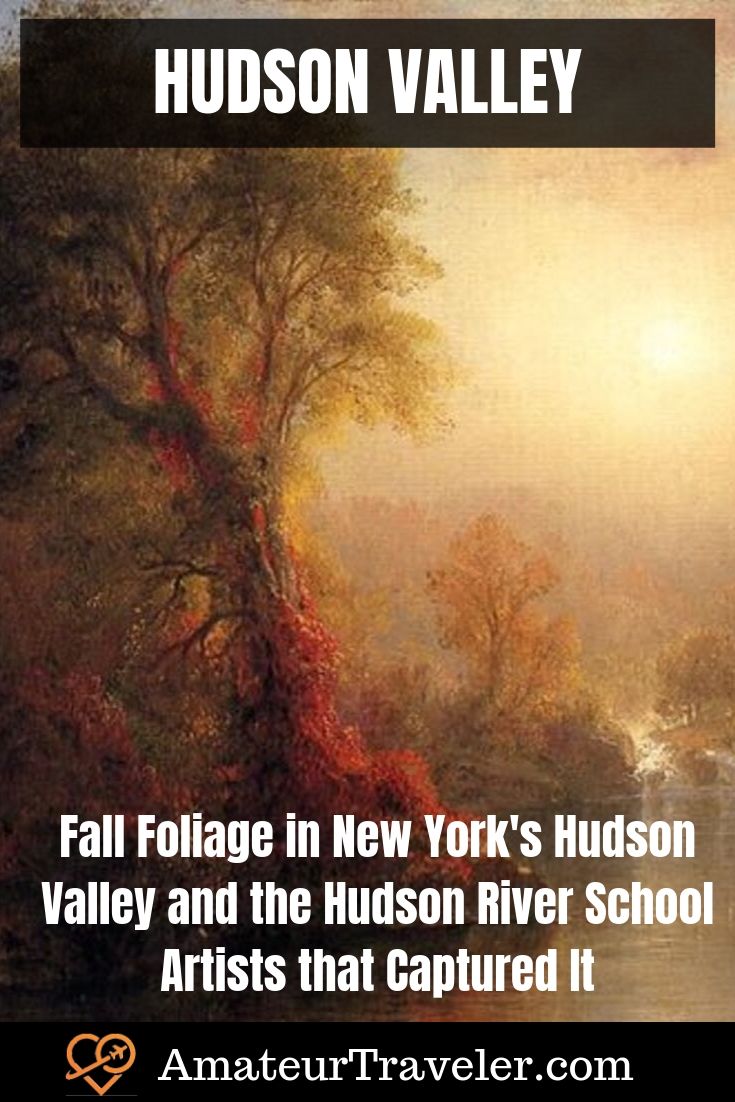
Located on the Shawangunk Mountain ridge, rising more than 2,000 feet above sea level, is Minnewaska State Park Preserve. The area features several waterfalls, three crystal clear lakes and sheer cliffs that reveal stunning views of the surrounding hardwood forests. Visitors can explore the park using its 35 miles of carriage roads and 50 miles of footpaths.
You can stretch your legs amidst the vibrant fall colors here, or spend most of the day exploring every inch. Either way, you’ll have witnessed the best Autumn has to offer.
Storm King Art Center
As our trip begins winding down, we continue traveling south from Minnewaska State Park towards one of the most fascinating museums in the world. In 1960, Storm King Art Center was launched as a museum for Hudson River School paintings. Over the years, however, Storm King’s focus evolved towards sculpture. Today, it’s home to one of the largest collections of contemporary outdoor sculptures in the country.
While Hudson River School artists drew inspiration from their natural surroundings, the art featured at Storm King becomes a part of the natural surroundings. The outdoor sculptures are scattered throughout the center’s 500-acre grounds, which is divided into four distinct areas. The landscape is carefully designed to form the perfect setting for each sculpture and includes rolling, grass-covered hills surrounded by tall trees. In Autumn, the fall colors form a rich backdrop for viewing the work of dozens of contemporary masters.
Newington-Cropsey Foundation
Our Hudson River Valley art and nature tour concludes another hour down the road on the outskirts of Yonkers, New York. Founded in 1977, the Newington-Cropsey Foundation preserves and displays the home of famed Hudson River Artist Jasper Cropsey.
A contemporary of Frederic Church, Jasper Cropsey began his career as an architectural savant — landing a coveted apprenticeship at just 14. A few years later, Cropsey discovered the work of Thomas Cole and set aside architecture to pursue landscape painting.
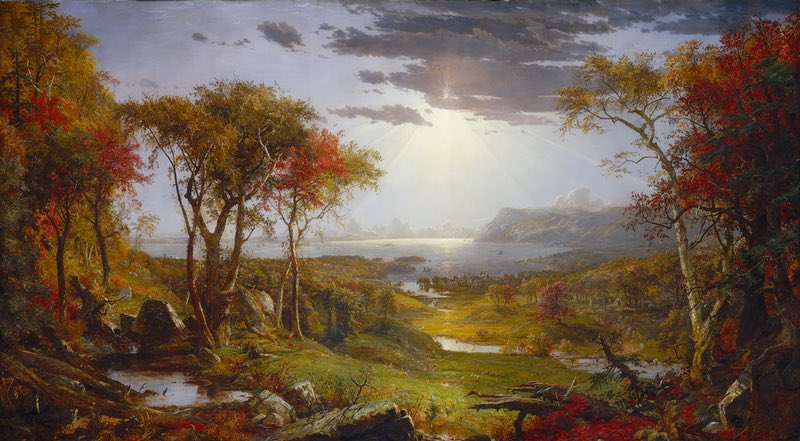
Cropsey, Jasper. Autumn on the Hudson River. 1860, National Gallery of Art.
After years spent traveling between Europe and the United States, Cropsey eventually took his place alongside Church and others as the early leaders of the Hudson River School movement. Cropsey’s most famous piece, Autumn on the Hudson River, now hangs in the National Gallery of Art.
Today, visitors can tour Cropsey’s home, called Ever Rest, and the art studio he designed later in life. The site also features a gallery of art containing most of the foundation’s collection of Cropsey’s work.
A Trip Through Time
Now our journey is at an end, just outside the largest city in the United States. It is here where the wild beauty of the Hudson River Valley comes into stark relief against the urban metropolis of New York. Perhaps more than ever, we appreciate the untamed and wild frontier Cole, Church, and Cropsey brought to the world some 200 years ago as we ruminate on how much has changed.
In the face of that forward progress, we’re fortunate to escape back into the woods for a bit, to revisit what those early masters first saw. All while enjoying nature’s perfect show — autumn in New York. This is a journey I won’t soon forget. While many people come to see fall foliage in New England, New York has been pleasing visitors for centuries.
Leave a Reply
Tags: article, hudson river, hudson valley, new york

 Camp in the Middle of it All
Camp in the Middle of it All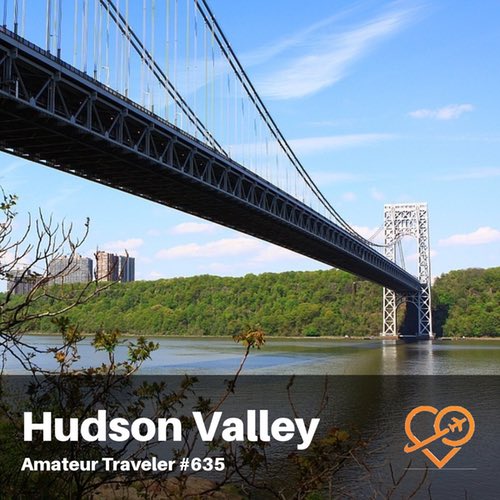 Travel to New York’s Hudson Valley – Episode 635
Travel to New York’s Hudson Valley – Episode 635 Travel the Northern Mississippi River Valley – Episode 658
Travel the Northern Mississippi River Valley – Episode 658 Hawai’i Nature Center – Iao Valley, Maui
Hawai’i Nature Center – Iao Valley, Maui A Summer Journey to Death Valley National Park
A Summer Journey to Death Valley National Park

